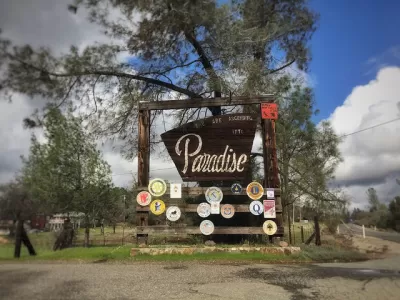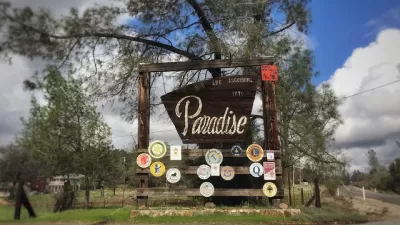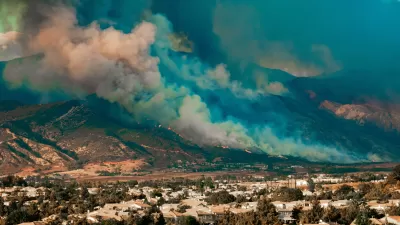Paradise, California—devastated by the deadly Camp Fire of 2018—is attracting new and returning residents as the city rebuilds its housing stock.

California’s latest population estimates show that Paradise—the Northern California town ravaged by the Camp Fire in 2018, which destroyed 10,000 buildings and killed 85 people—has seen the fastest population growth in the state in the last year.
According to estimates from the California Department of Finance, "the population of Paradise rose from 4,608 people as of Jan. 1, 2020, up to 6,046 a year later," reports Vincent Moleski.
"The town’s 31.2% leap in population outpaces the rest of the state, much of which reflected a decrease in population amid low birth rates and slower immigration," adds Moleski. The figure are even more of any outlier compared next to the totals for the entire state, which dropped in 2020 for the first time in recorded state history, as documented in an article yesterday by Planetizen correspondent Irvin Dawid.
Moleski takes the additional step of naming the cause of Paradise's influx or population: new housing construction rising from the ashes of the Camp Fire. In addition to outpacing the rest of the state in population growth, Paradise has also been outpacing the state on housing construction. "Department of Finance data show that the town increased its total housing by 32.1% in 2020, the fastest rate in the state. Much of this construction has been in single-family homes. The town’s number of single-family homes rose by nearly 40.7%, while its multi-family homes increased by 11.5%."
As documented in an article by Natalie Hanson for the Chico Enterprise-Record in December 2020, the bulk of the city's building permits have been issued to residents looking to rebuild homes lost in the Camp Fire.
FULL STORY: Paradise's population surges, fueled by new housing construction in wake of Camp Fire

Study: Maui’s Plan to Convert Vacation Rentals to Long-Term Housing Could Cause Nearly $1 Billion Economic Loss
The plan would reduce visitor accommodation by 25,% resulting in 1,900 jobs lost.

Alabama: Trump Terminates Settlements for Black Communities Harmed By Raw Sewage
Trump deemed the landmark civil rights agreement “illegal DEI and environmental justice policy.”

Why Should We Subsidize Public Transportation?
Many public transit agencies face financial stress due to rising costs, declining fare revenue, and declining subsidies. Transit advocates must provide a strong business case for increasing public transit funding.

Paris Bike Boom Leads to Steep Drop in Air Pollution
The French city’s air quality has improved dramatically in the past 20 years, coinciding with a growth in cycling.

Why Housing Costs More to Build in California Than in Texas
Hard costs like labor and materials combined with ‘soft’ costs such as permitting make building in the San Francisco Bay Area almost three times as costly as in Texas cities.

San Diego County Sees a Rise in Urban Coyotes
San Diego County experiences a rise in urban coyotes, as sightings become prevalent throughout its urban neighbourhoods and surrounding areas.
Urban Design for Planners 1: Software Tools
This six-course series explores essential urban design concepts using open source software and equips planners with the tools they need to participate fully in the urban design process.
Planning for Universal Design
Learn the tools for implementing Universal Design in planning regulations.
Smith Gee Studio
Alamo Area Metropolitan Planning Organization
City of Santa Clarita
Institute for Housing and Urban Development Studies (IHS)
City of Grandview
Harvard GSD Executive Education
Toledo-Lucas County Plan Commissions
Salt Lake City
NYU Wagner Graduate School of Public Service





























